 Chris Hamilton
.
August 18, 2023
.
Features
Chris Hamilton
.
August 18, 2023
.
Features

CENTENNIAL CELEBRATIONS DON’T COME AROUND VERY OFTEN. The ability to hit a mark so prestigious garners nothing but admiration and respect from loyal consumers, next-gen enthusiasts and even industry competitors alike.
Quite a few companies are celebrating 100 years of hard work in 2018, including John Deer’s entrance into the tractor business and the birth of electronics giant Panasonic. Now one of America’s most iconic truck manufacturers is also included in those century-long stats as 2018 officially marks 100 years of Chevy trucks in production. We are honored to salute the company’s accomplishments the best way we know how.
This long-running staple of the automotive industry has continually improved its engineering, testing and development over the years to ensure a constantly evolving product in the lineage of consumer-based Chevy trucks. Whether you are a blue-collar base-model buyer or a top-of-the-line diesel diehard, you have the same bowtie-infused blood that has kept this amazing company moving forward over the many years. Even if the famous blue oval is your truck of choice, you’ve got to show some love for the brand that makes its competition stronger year after year. Iron sharpens iron, and one can’t grow without the other, but we know how passionate you guys are about your four-lettered favorite, so you can continue to hide your Chevy sentiments when you’re around all the other Ford fanatics.
Starting on or around 1918 with a focus on freedom, American companies in all industries and locations around the country pushed the boundaries of human innovation beyond limits once thought possible. Combustion engines were on the rise and there was a demand for gas-powered people pushers like never before.
By that time, Chevrolet had already been on the forefront of innovation and established as a prominent American auto manufacturer, but after differences with co-founder William C. Durant over design, Louis Chevrolet sold Durant his share in the company. Eventually Durant became president of General Motors, and Chevrolet was merged into GM as a separate division. In 1918, Chevrolet’s factories were located at Flint, Michigan, and the truck line was in full-scale production and the first official Chevrolet pickup is born.
The truck was meant to be an affordable and flexible platform for customers to build on, and could be purchased as either a cowl and chassis or an express body. With a suggested retail price of $1,325 this 36-hp, four-cylinder pickup was affordable for the average household income. Follow along as we highlight the best of the best along Chevy’s amazing timeline.
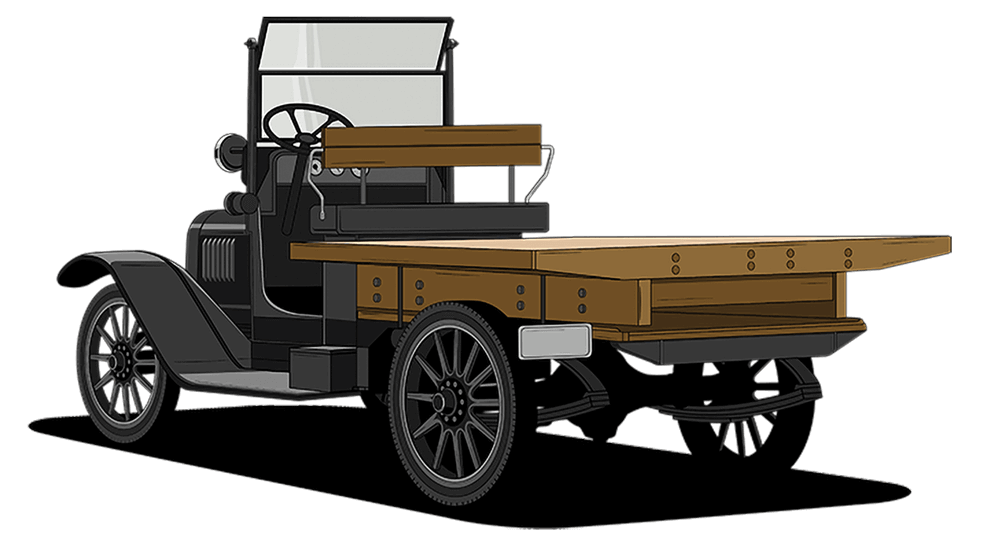
THE year 1918 was a very important one for Chevrolet. Not only did the company officially merge with General Motors, but it also debuted its first ever truck! Motorized vehicles had replaced fleshy beasts of burden across the nation, but automobiles such as Chevrolet’s newly introduced pickup—its first ever—weren’t huge on power compared to modern trucks. However, they offered owners more than enough grunt to haul most anything on the farm, or across America’s fledgling towns and cities.
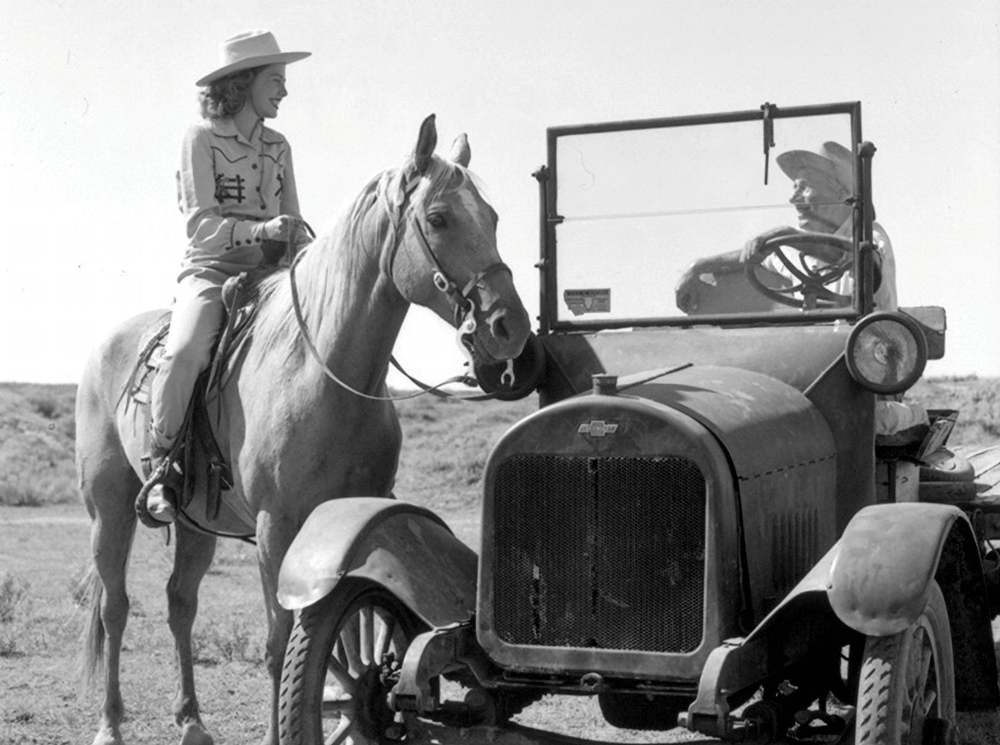
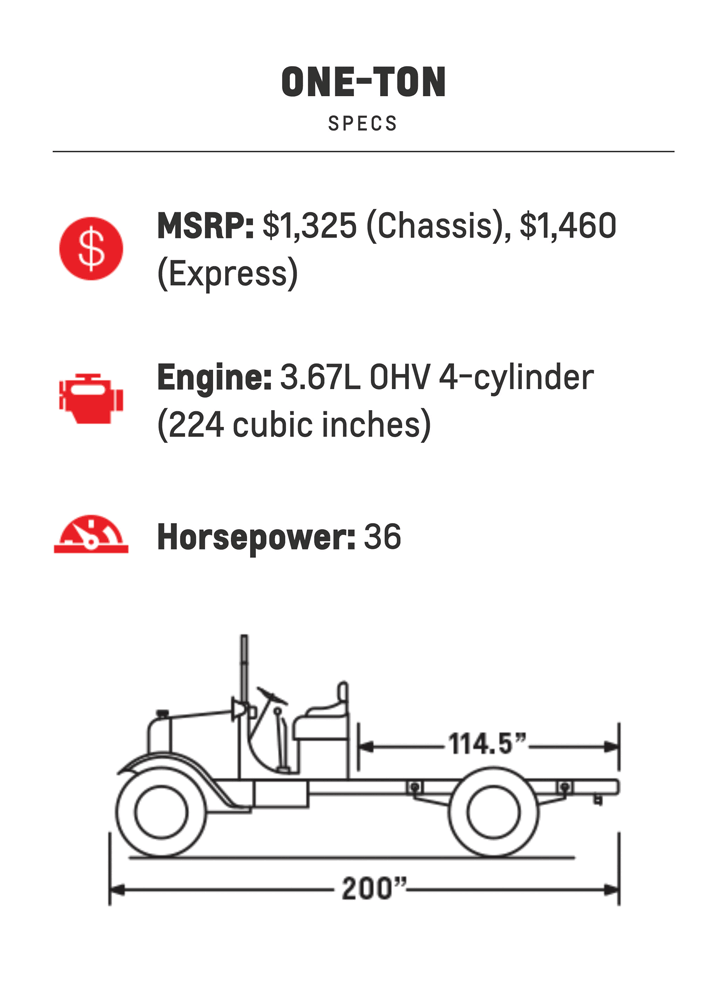
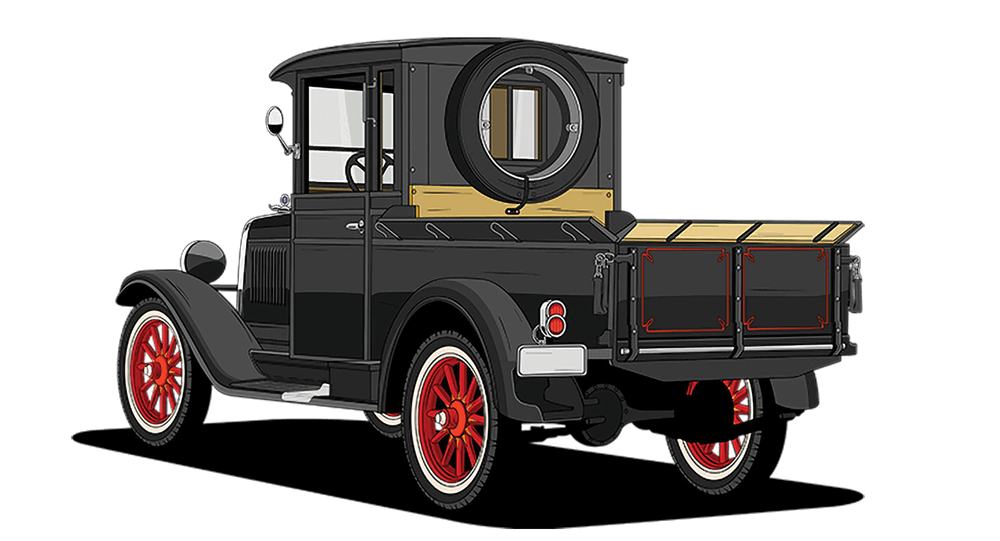
BY 1929, Chevy started making some major changes to its line of trucks, with the transition to the new “stove bolt” 194-cubic-inch inline-six engine design, as well as a closed-cab design. Up until now, all Chevy trucks had been roadsters with optional folding tops. Beginning in 1931, the company also began offering solid-sided beds, making this the first time an actual pickup was available from the factory.
Another major change was that steel disc wheels now replaced the wood-spoked wheels, adding strength and reliability to the evolving platform. Although no one knew it at the time, similarly styled solid wheels would become a popular customizing choice decades later! In general, however, the trucks themselves are often stripped down and built as traditional hot rods, with the crustiest among the ending up as rat rods.
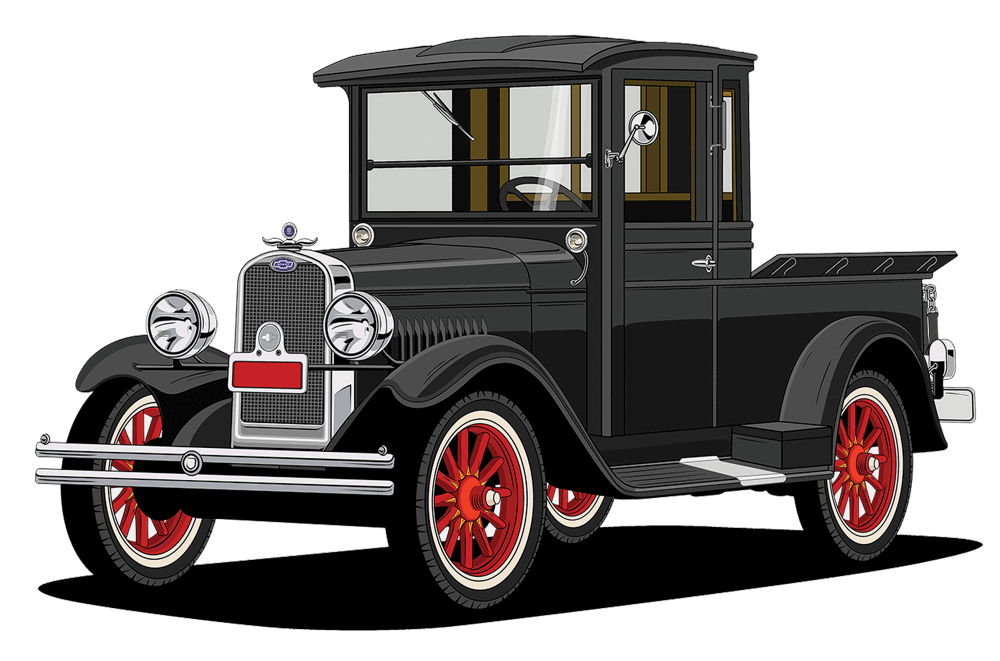
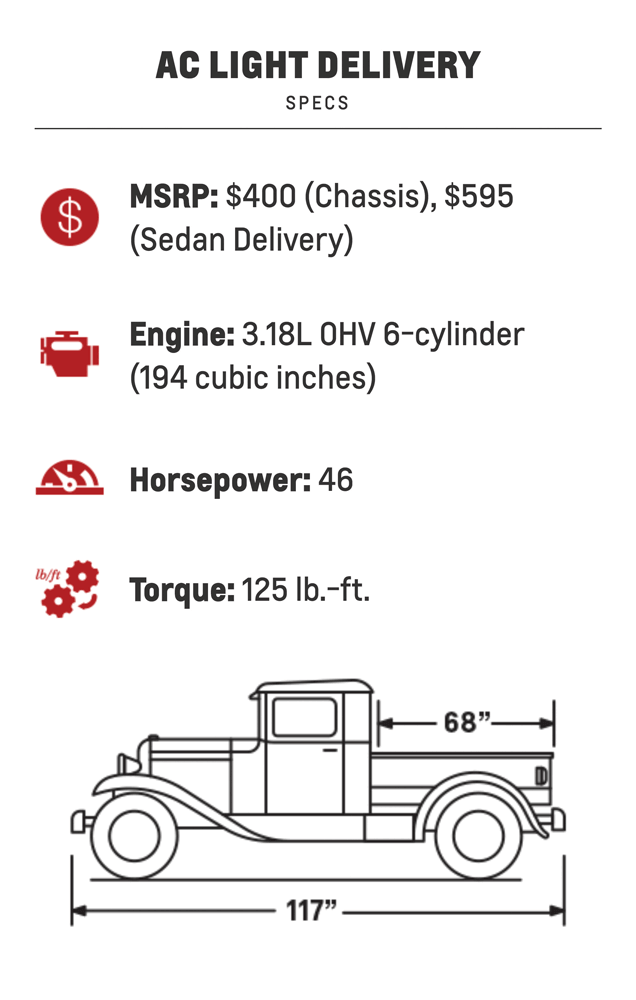
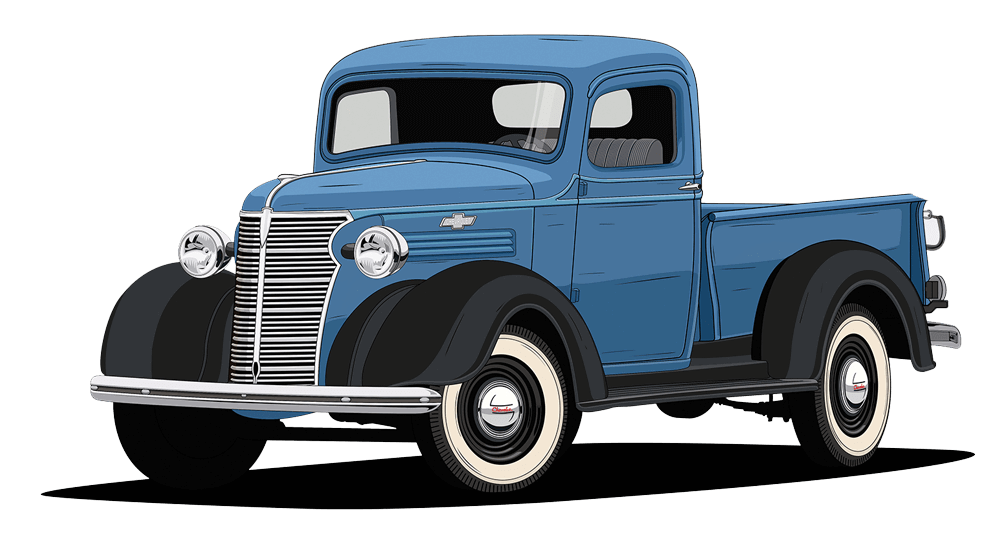
WITH this next generation of trucks, Chevy finally began to differentiate itself from other makes with a bold new design, which was the first to be produced by the company’s new art and color department. The Art Deco movement was in full swing by the late 1930s, and its influence is clearly visible here. The much more rounded aesthetics were a big hit with consumers, who now had plenty of other choices within the growing pickup market segment. Swept-back fenders and a fl owing vertical grille shell added a gracefulness not yet seen in a Chevrolet truck!
Consumer availability was halted from 1943-1945 because of World War II, but GM continued to build trucks for military use. Because of this, it’s not unheard of to be able to buy a ’43-45 truck these days as ex-surplus or decommissions, even though cars of the same vintage are virtually nonexistent.
And with such a beautiful design, it’s no wonder that these Art Deco-inspired trucks would eventually become so popular to customize. Everything from kustom taildraggers to hot rods and modern street machines have been built from ‘36-46 Chevy p pickups, and we love them all.
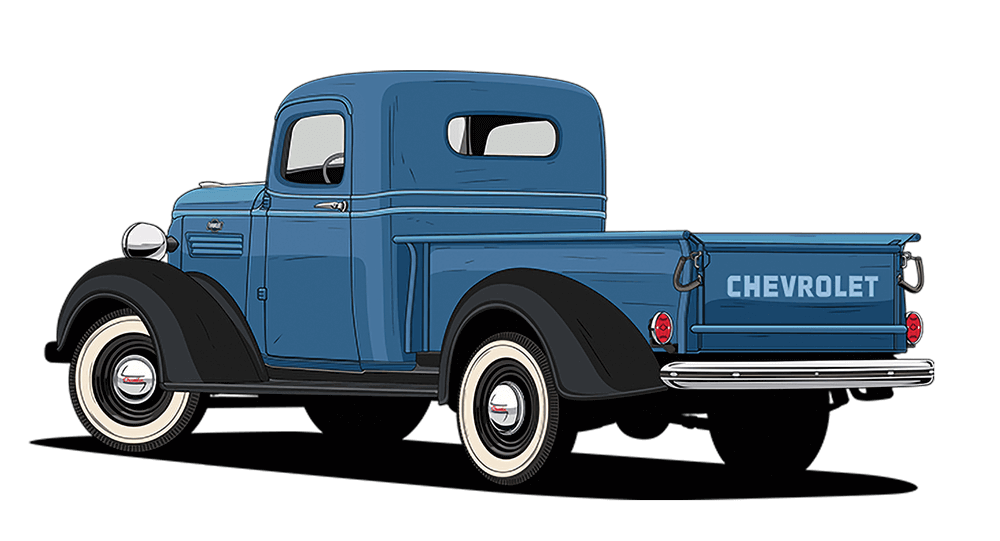
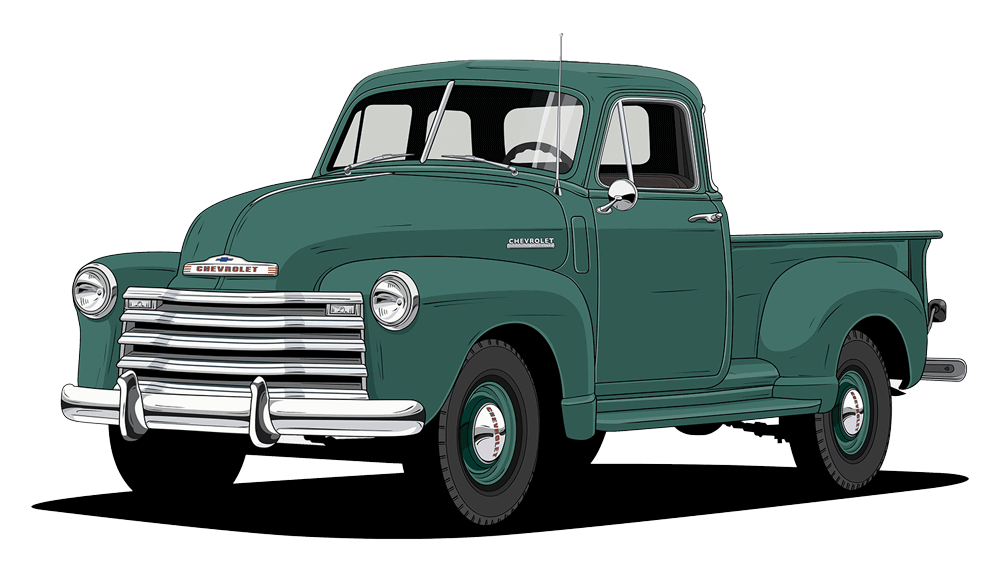
CONSIDERED by many to be the most beautiful truck that GM ever produced, the Advanced Design series of trucks have certainly withstood the test of time as one of the most stunning designs to ever come out of Detroit.
It quickly became the bestselling truck on the market and was continually refined and improved over the years. The biggest changes came in 1954, with the introduction of the one-piece windshield, horizontal bed rails to replace the previous angled rails and round taillights.
An assortment of inline sixes was offered throughout the model run, beginning with the 216 cubic inch through 1953, and then moving through the 235 and 261 cubic-inchers toward the end of the model run. 1954 was the first year that a Turbo Hydramatic trans would be offered, and holdover 1955 “First Series” trucks were finally treated to an open driveline configuration before the redesigned Task Force pickups were introduced.
These days, the AD truck can most often be seen as a street machine, but they are also popular as kustoms.
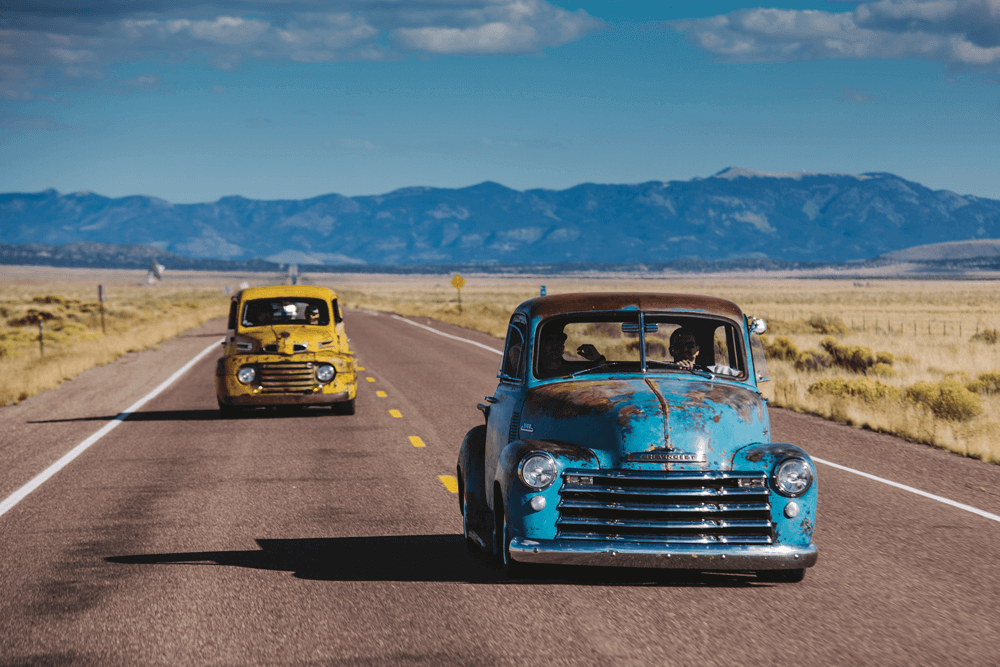
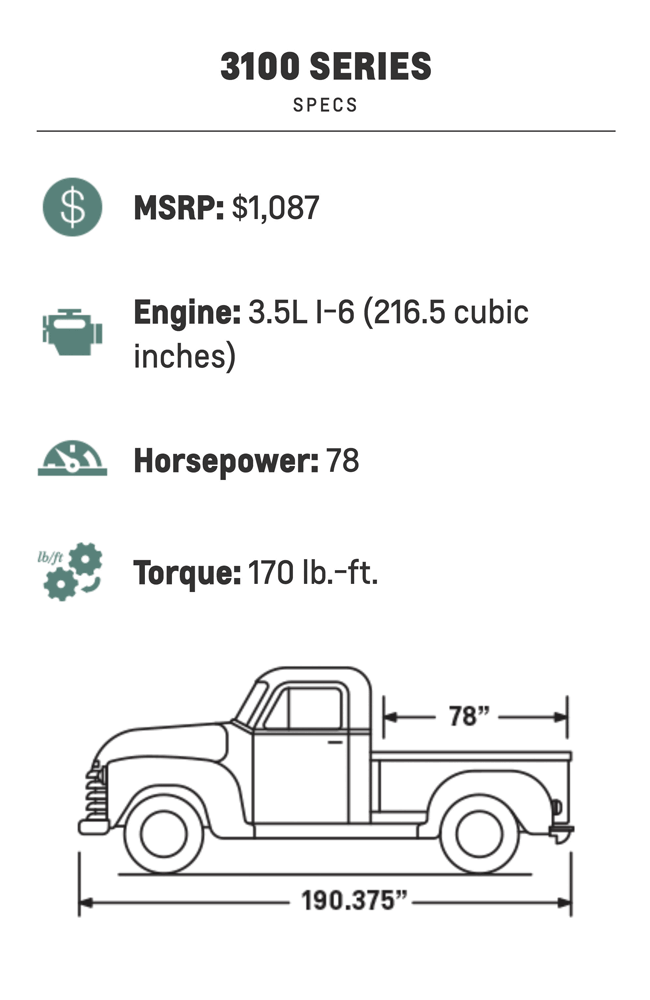
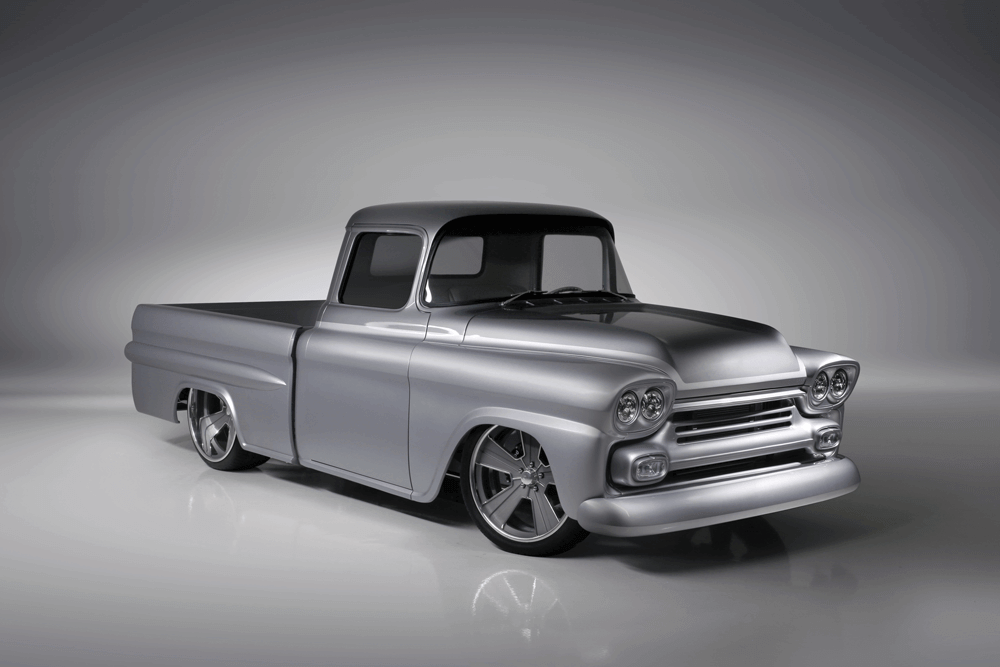
THE “Second Series,” or Task Force, was a big deal when it debuted in 1955. A new 12-volt electrical system was now standard on all trucks, and helped better start available engines, such as the newly available 265-cubic-inch V-8.
Chevy trucks would now feature a wrap-around windshield, which was actually a first for any truck on the market. And with style reminiscent of the now-legendary tri-five cars of the same era, these trucks are absolutely gorgeous whether stock or modified.
The “Cameo Carrier” introduced the first fleetside bed on a Chevy, which would become a popular option on trucks from then on.
The 1958 models debuted with twin headlights, mimicking the look of the new 1958 Impala. 1959 models received only minor cosmetic changes in anticipation of the upcoming release of the C-10.
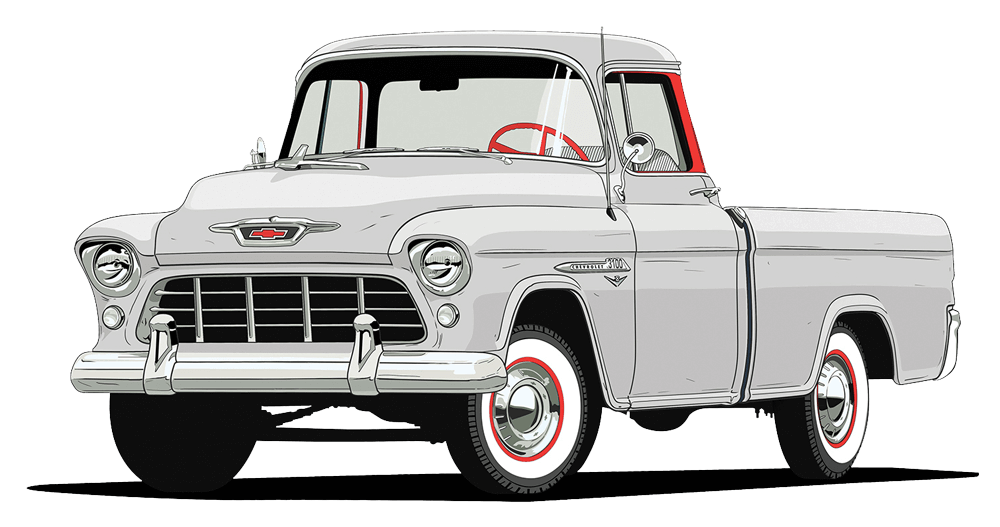
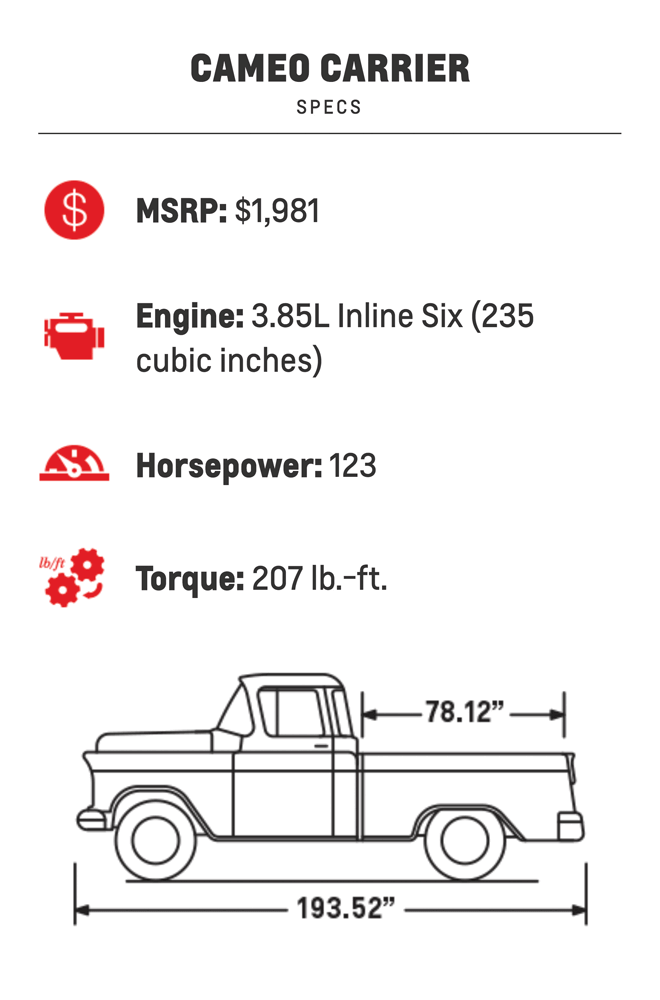
THE 1960-1962 C-10s received a newly designed independent front torsion bar suspension and trailing arm rear suspension, which greatly improved ride quality compared to the previous beam front and leaf spring rear suspension.
The 1963 models were the first to get coil spring front suspensions, and were the last year to have the wraparound “knee-knocker” windshield and distinctive double-hump dashboard. Because of these attributes, 1963 C-10s are the favorite of many truck enthusiasts, but then again many prefer the more angular side view of the ’64-66 trucks. Various inline-six engines could be had over the seven years of production, as well as a 283- or 327-cubic-inch V-8.
This generation C-10 is equally at home as a muscle truck, kustom or pro touring ride, and it remained a hidden gem in the truck scene for many years. Popularity seemed to greatly increase in the early 2000s and has become a favorite of many since.
In 1967, Chevy brought about yet another design change, and its “Action Line” trucks now featured an even bolder look, as well as a bigger focus on driver comfort. Gone was the angular look of its predecessor, in favor of more simplified lines. More plush and ornate interiors were a big improvement over previous models, and engine choices ranged from a capable 250-cubicinch inline-six to a 402-cubic-inch big block V-8.
If you wanted a small back window, you had to get in early on the ’67 models, as that was the only year it would be available on anything but C-40 and C-60 models. Aside from that, slight cosmetic changes occurred every model year, with the most obvious being the front ends between ’68 and ’69 models, which were beefed up aesthetically.
Beginning in ’71, interiors were improved yet again with more padding, and exteriors could be had with more brightwork. More importantly, the front brakes were now discs!
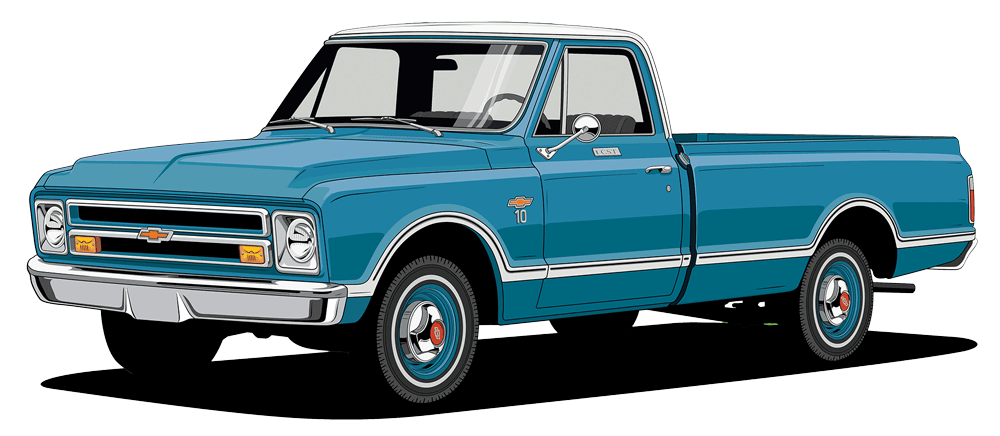
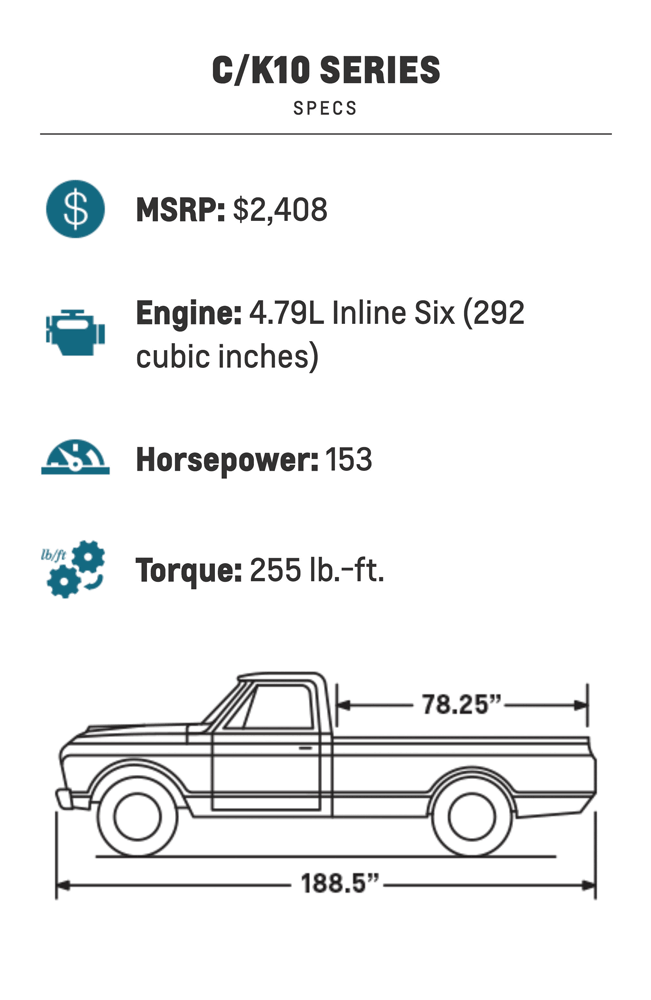
SOMEHOW, this generation is called both a “squarebody” and a “rounded line” truck, and much like trying to fit a square peg in a round hole, we’ve never been able to make any sense of it! Be that as it may, everyone’s new favorite C-10 has actually had a cult following since its inception. And as blunt as its front end has been over the years, it was aerodynamically superior to the previous generation C-10!
All in all, the squarebody was definitely the best Chevy truck to date, and was the first to have features such as curved side glass and an antenna embedded into the windshield.
The squarebody was also the first GM truck to become available in consumer friendly dually version. Sure, duallies were available in previous versions, but the ’73 and newer C-30s could now be optioned out just as much as their lighter duty siblings, and they came from the factory with a complete bed.
Tons of options were available, from various trim packages to engine choices that included a 454 big block!
Those who prefer a more classic look tend to go for the more rounded ’73-80s, but those who want the best that the squarebody had to off er tend to look for ’87 models (which is designated as an R-series), as that was the first year for TBI (throttle body injection). The 1981-87 trucks got the “brick” front end with stacked headlights, with minor updates throughout the years. And yes, squarebody variants such as crew cabs, duallies, and Blazers were made through the 1991 model year.
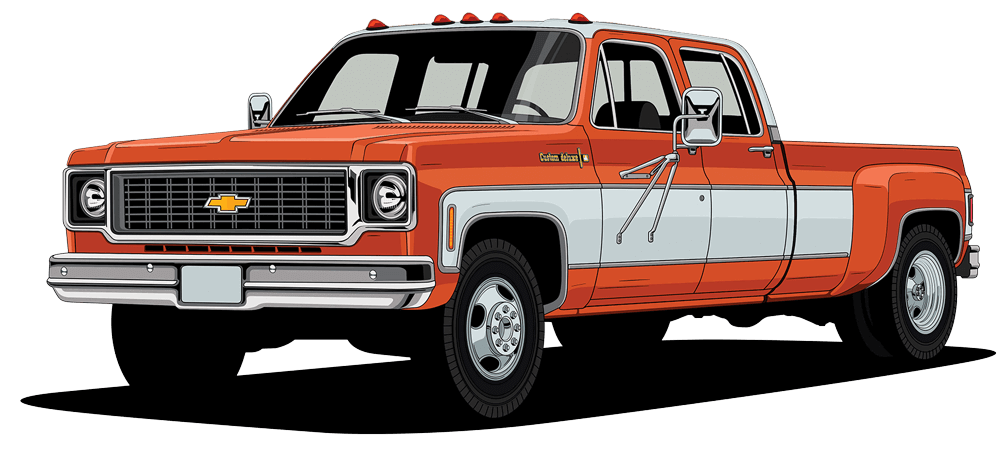
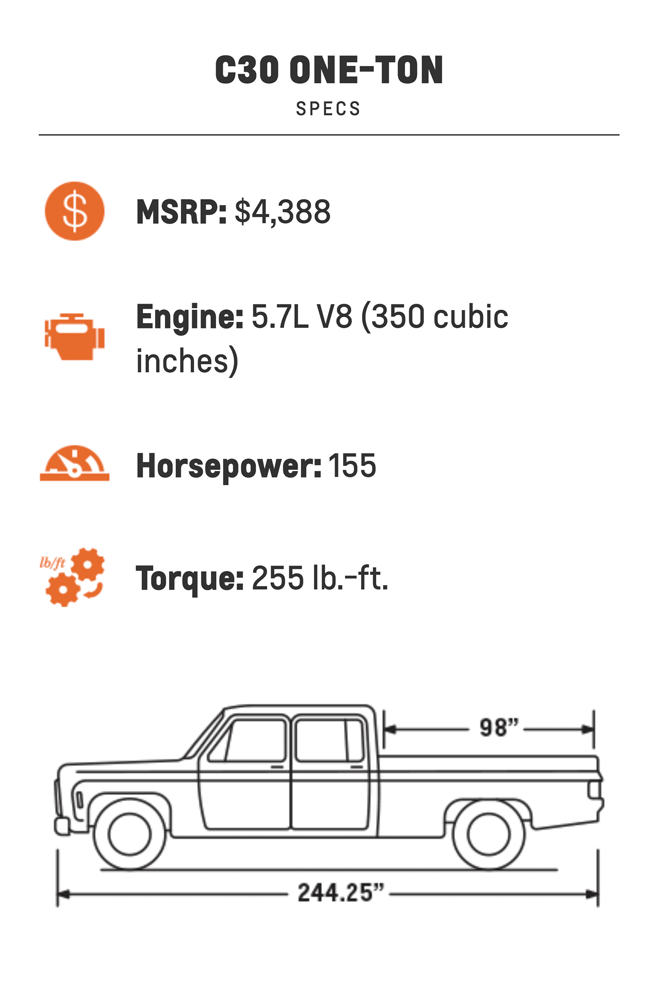
What parts and accessories are available for restoring or maintaining classic Chevy trucks?
Restoring or maintaining a classic Chevy truck requires a diverse range of parts and accessories to ensure it runs smoothly and looks great. Here’s a comprehensive outline of what you might need:
Whether you’re aiming for a showroom-quality restoration or simply seeking to maintain your truck’s functionality, these parts and accessories are essential. Ensuring you have the highest quality components will not only preserve the classic appeal of your Chevy truck but also guarantee its reliability on the road.
What are the different generations of Chevrolet trucks from 1947 to 2013?
From 1947 to 2013, Chevrolet trucks evolved through several distinct generations, each marked by unique features and design changes. Here’s a concise guide to understanding these generational shifts:
This era marks the introduction of the first post-WWII Chevrolet truck platform. Known as the Advance Design, these trucks were characterized by their rounded lines and were produced from 1947 through the first series of 1955.
The Task Force series began with the mid-1955 models. Notably, this period saw a transition where early 1955 models (1st Series) retained the older design, while the latter half (2nd Series) introduced a more modern style.
The 1960 redesign introduced the C/K designations, standing for two-wheel (“C”) and four-wheel drive (“K”) models. This generation featured a lower cab placement due to a new drop-center ladder frame and more advanced suspension for a smoother ride.
Known among enthusiasts as the Action Line, these trucks typically had coil spring rear suspensions for two-wheel-drive models, while four-wheel-drive versions maintained leaf springs on both axles.
This generation, internally termed the “Rounded Line” because of its curved windshields and windows, is sometimes referred to as the “Square Body” due to its boxy shape. In 1987, models were renamed to R (two-wheel drive) and V (four-wheel drive).
The fourth generation, also referred to as the GMT400, brought in significant advancements like independent front suspensions on all models. Enthusiasts sometimes call these the “Old Body Style” (OBS) trucks.
The introduction of the Silverado name marked this period, replacing the C/K nomenclature. This line is often dubbed the “New Body Style” (NBS) by truck enthusiasts.
The GMT900 series became renowned for their reliability and were widely used in commercial fleets. These trucks gathered a wealth of data for their enduring performance and durability in real-world conditions.
These generational shifts highlight the progression and innovation within Chevrolet’s truck lineup, reflecting both technological advances and changing consumer preferences over the decades.
How did the design and features of the 1973-1986 Chevy C/K and 1987-1991 Chevy R/V Series trucks change over time?
The design and features of Chevy’s C/K and R/V Series trucks underwent significant changes from 1973 through 1991, reflecting advancements in both functionality and style.
In 1973, the C/K series kicked off with a refresh that included wind tunnel testing for improved aerodynamics. This generation, internally dubbed the “Rounded Line,” featured extended wheelbases and offered a dual rear wheel option on one-ton pickups. Rounded corners in key areas, such as the windshield and side windows, were notable design elements.
Throughout these years, Chevy’s trucks evolved in both form and function to meet the demands of consumers, blending rugged utility with innovations in comfort and technology.
What were the key updates in the 1988-1998 Chevy C/K Series (GMT400) trucks?
The 1988-1998 Chevy C/K Series, also known as the GMT400 platform, introduced several significant updates over its production run. Here are the highlights:
These updates made the 1988-1998 Chevy C/K Series trucks a robust, performance-oriented, and safer option for truck enthusiasts.
What significant changes were introduced in the 1955-1959 Chevy Task Force trucks?
THE “Second Series,” or Task Force, was a big deal when it debuted in 1955. A new 12-volt electrical system was now standard on all trucks, and helped better start available engines, such as the newly available 265-cubic-inch V-8.
Chevy trucks would now feature a wrap-around windshield, which was actually a first for any truck on the market. And with style reminiscent of the now-legendary tri-five cars of the same era, these trucks are absolutely gorgeous whether stock or modified.
The “Cameo Carrier” introduced the first fleetside bed on a Chevy, which would become a popular option on trucks from then on.
The 1958 models debuted with twin headlights, mimicking the look of the new 1958 Impala. 1959 models received only minor cosmetic changes in anticipation of the upcoming release of the C-10.
As Chevrolet transitioned to the Task Force platform, the 1955 1st Series trucks continued the earlier design, while the 1955 2nd Series trucks introduced the new design elements.
A prime example of this era is the restored 1958 Chevrolet Cameo in Tartan Turquoise with Onyx Black accents. With only about 1,400 units built in 1958, this model is a rare find today.
These changes not only highlighted advancements in technology and design but also set a new standard for what a pickup truck could be. The Task Force series remains a beloved chapter in Chevrolet’s history, celebrated by collectors and enthusiasts alike.
How can one identify the specific year of a Chevy truck from 1947-1972 based on design changes?
“THE 1960-1962 C-10s received a newly designed independent front torsion bar suspension and trailing arm rear suspension, which greatly improved ride quality compared to the previous beam front and leaf spring rear suspension. The 1963 models were the first to get coil spring front suspensions, and were the last year to have the wraparound “knee-knocker” windshield and distinctive double-hump dashboard. Because of these attributes, 1963 C-10s are the favorite of many truck enthusiasts, but then again many prefer the more angular side view of the ’64-66 trucks. Various inline-six engines could be had over the seven years of production, as well as a 283- or 327-cubic-inch V-8. This generation C-10 is equally at home as a muscle truck, kustom or pro touring ride, and it remained a hidden gem in the truck scene for many years. Popularity seemed to greatly increase in the early 2000s and has become a favorite of many since.
In 1967, Chevy brought about yet another design change, and its “Action Line” trucks now featured an even bolder look, as well as a bigger focus on driver comfort. Gone was the angular look of its predecessor, in favor of more simplified lines. More plush and ornate interiors were a big improvement over previous models, and engine choices ranged from a capable 250-cubic-inch inline-six to a 402-cubic-inch big block V-8. If you wanted a small back window, you had to get in early on the ’67 models, as that was the only year it would be available on anything but C-40 and C-60 models. Aside from that, slight cosmetic changes occurred every model year, with the most obvious being the front ends between ’68 and ’69 models, which were beefed up aesthetically. Beginning in ’71, interiors were improved yet again with more padding, and exteriors could be had with more brightwork. More importantly, the front brakes were now discs!”
This quick reference guide to Chevy truck generations should help you narrow down the year range of any GMtruck you see, but what if you need to know the exact year? We can help with that. Check out our detailed guides below, which list the changes between each year of 1947-1972 Chevy trucks:
By referring to these guides, you can pinpoint the specific year of any Chevy truck from 1947 to 1972 based on design changes.
What are the notable features of the 1967-1972 Chevy C/K Series trucks?
THE 1960-1962 C-10s received a newly designed independent front torsion bar suspension and trailing arm rear suspension, which greatly improved ride quality compared to the previous beam front and leaf spring rear suspension.
The 1963 models were the first to get coil spring front suspensions, and were the last year to have the wraparound “knee-knocker” windshield and distinctive double-hump dashboard. Because of these attributes, 1963 C-10s are the favorite of many truck enthusiasts, but then again many prefer the more angular side view of the ’64-66 trucks. Various inline-six engines could be had over the seven years of production, as well as a 283- or 327-cubic-inch V-8.
This generation C-10 is equally at home as a muscle truck, kustom or pro touring ride, and it remained a hidden gem in the truck scene for many years. Popularity seemed to greatly increase in the early 2000s and has become a favorite of many since.
In 1967, Chevy brought about yet another design change, and its “Action Line” trucks now featured an even bolder look, as well as a bigger focus on driver comfort. Gone was the angular look of its predecessor, in favor of more simplified lines. More plush and ornate interiors were a big improvement over previous models, and engine choices ranged from a capable 250-cubic-inch inline-six to a 402-cubic-inch big block V-8.
Aside from that, slight cosmetic changes occurred every model year, with the most obvious being the front ends between ’68 and ’69 models, which were beefed up aesthetically.
How did the Chevy C/K Series trucks evolve between 1960 and 1966?
THE 1960-1962 C-10s received a newly designed independent front torsion bar suspension and trailing arm rear suspension, which greatly improved ride quality compared to the previous beam front and leaf spring rear suspension.
The 1960 model year also introduced the C/K designations, with “C” for 2-wheel drive models and “K” for 4-wheel drive models. This redesign featured a drop-center ladder frame, allowing the cab to sit lower for a more car-like ride experience. The series did not receive a special name like its predecessors but showcased a refined engineering approach.
The 1963 models were the first to get coil spring front suspensions and were the last year to have the wraparound “knee-knocker” windshield and distinctive double-hump dashboard. Because of these attributes, 1963 C-10s are the favorite of many truck enthusiasts, but then again many prefer the more angular side view of the ’64-66 trucks.
In 1963, the C/K series transitioned to a coil spring front suspension, which replaced the torsion bar system used in the earlier models. This year also marked the end of the unique wraparound windshield, known for its distinctive style, and the beginning of a more angular design that continued through 1966.
Various inline-six engines were available throughout the seven years of production, as well as a 283- or 327-cubic-inch V-8. By 1964, the trucks adopted a flat windshield design, a notable shift from the previous “knee-knocker” style.
Various inline-six engines could be had over the seven years of production, as well as a 283- or 327-cubic-inch V-8.
Additionally, Chevrolet trucks during this period were available with smooth “Fleetside” or fendered “Stepside” beds, while GMC referred to these as “Wideside” and “Fenderside.” The introduction of the 327ci V8 engine and the Turbo-Hydramatic transmission in 1966 marked significant advancements in power and efficiency.
For those interested in the memorable model names of the 1960-66 GM trucks, check out our article “Behind the Names: Chevrolet Apache, Viking, and Spartan.”
This blend of engineering innovation and design evolution makes the 1960-1966 Chevy C/K Series a fascinating chapter in automotive history.
What were the unique features of the 1973 Chevrolet C30 One-Ton Dually?
The 1973 Chevrolet C30 One-Ton Dually showcased several distinctive features that set it apart as a pioneering heavy-duty pickup. A major highlight was its introduction of the “square body” design, which improved aerodynamics and optimized fuel efficiency. This design evolution marked a significant shift in pickup aesthetics and performance.
The C30 was notable for its dual rear wheels, a feature that enhanced stability and load-carrying capacity, making it ideal for heavy-duty tasks. It also provided a stronger platform suited for both commercial and personal uses. This model is often recognized as one of the first modern heavy-duty trucks, setting a standard for future designs in the category.
How did the first generation C/K trucks from 1960 to 1966 serve different purposes?
THE 1960-1962 C-10s received a newly designed independent front torsion bar suspension and trailing arm rear suspension, which greatly improved ride quality compared to the previous beam front and leaf spring rear suspension.
The first generation of Chevy C/K trucks, spanning from 1960 to 1966, quickly became the go-to pickup for both work and recreational activities. The 1960 model year introduced the C/K designations, with “C” for 2-wheel drive models and “K” for 4-wheel drive models, highlighting their versatility in various terrains and conditions.
This redesign featured a drop-center ladder frame, allowing the cab to sit lower for a more car-like ride experience. The series did not receive a special name like its predecessors but showcased a refined engineering approach capable of handling diverse tasks.
The 1963 models were the first to get coil spring front suspensions and were the last year to have the wraparound “knee-knocker” windshield and distinctive double-hump dashboard. Because of these attributes, 1963 C-10s are the favorite of many truck enthusiasts, but then again many prefer the more angular side view of the ’64-66 trucks.
In 1963, the C/K series transitioned to a coil spring front suspension, replacing the torsion bar system used in the earlier models. This year also marked the end of the unique wraparound windshield, known for its distinctive style, and the beginning of a more angular design that continued through 1966.
Various inline-six engines were available throughout the seven years of production, as well as a 283- or 327-cubic-inch V-8. By 1964, the trucks adopted a flat windshield design, a notable shift from the previous “knee-knocker” style.
Various inline-six engines could be had over the seven years of production, as well as a 283- or 327-cubic-inch V-8.
Additionally, Chevrolet trucks during this period were available with smooth “Fleetside” or fendered “Stepside” beds, while GMC referred to these as “Wideside” and “Fenderside.” The introduction of the 327ci V8 engine and the Turbo-Hydramatic transmission in 1966 marked significant advancements in power and efficiency.
By 1965, nearly half of all Chevy trucks sold since 1918 were still on the road, testifying to their durability and continued relevance in both professional and personal settings. This blend of engineering innovation and design evolution makes the 1960-1966 Chevy C/K Series a fascinating chapter in automotive history.
For those interested in the memorable model names of the 1960-66 GM trucks, check out our article “Behind the Names: Chevrolet Apache, Viking, and Spartan.”
What general roles or purposes did the first generation C/K trucks serve?
The first generation C/K trucks were widely used as reliable vehicles for both work-related tasks and recreational activities, highlighting their versatility and appeal in various settings.
How prevalent were Chevy trucks from this era on the road in the mid-1960s?
By 1965, almost 50% of the Chevy trucks sold since 1918 were still operational, showcasing their remarkable durability and longevity.
How did Chevrolet trucks contribute to the war effort from 1939 to 1946?
Consumer availability was halted from 1943-1945 because of World War II, but GM continued to build trucks for military use. Because of this, it’s not unheard of to be able to buy a ’43-45 truck these days as ex-surplus or decommissions, even though cars of the same vintage are virtually nonexistent.
During the war, Chevrolet played a crucial role in supporting the military efforts through extensive manufacturing conversions. In 1942, the company pivoted all its factories to focus exclusively on war production. This included the creation of military 6×6 trucks, which were essential for transporting troops and supplies across challenging terrains. Additionally, Chevrolet produced key components for aircraft engines, ensuring the air force remained equipped for combat.
Moreover, Chevrolet was instrumental in producing 90 mm cannon barrels, vital for the artillery units. One of their notable achievements was the development of the T17E1 “Staghound,” a robust 14-ton armored car powered by two 6-cylinder engines. This vehicle exemplified the innovative engineering that bolstered the Allied forces.
By seamlessly integrating civilian manufacturing capabilities into military production, Chevrolet not only supported the war effort but also left a legacy of engineering excellence that impacted both military and civilian sectors.
How were Chevrolet’s factories utilized during the war?
In 1942, Chevrolet repurposed all its factories to support the war effort, focusing entirely on military production.
What specific military vehicles and equipment did Chevrolet produce during the war?
Chevrolet manufactured a range of military items, including 6×6 trucks, components for aircraft engines, 90 mm cannon barrels, and the T17E1 “Staghound,” which was an armored car.
How did the 1967 Chevrolet C10 Fleetside compare in terms of specifications and pricing?
The 1960-1962 C-10s received a newly designed independent front torsion bar suspension and trailing arm rear suspension, which greatly improved ride quality compared to the previous beam front and leaf spring rear suspension.
The 1960 model year also introduced the C/K designations, with “C” for 2-wheel drive models and “K” for 4-wheel drive models. This redesign featured a drop-center ladder frame, allowing the cab to sit lower for a more car-like ride experience. The series did not receive a special name like its predecessors but showcased a refined engineering approach.
The 1963 models were the first to get coil spring front suspensions and were the last year to have the wraparound “knee-knocker” windshield and distinctive double-hump dashboard. Because of these attributes, 1963 C-10s are the favorite of many truck enthusiasts, but then again many prefer the more angular side view of the ’64-66 trucks.
In 1963, the C/K series transitioned to a coil spring front suspension, which replaced the torsion bar system used in the earlier models. This year also marked the end of the unique wraparound windshield, known for its distinctive style, and the beginning of a more angular design that continued through 1966.
Various inline-six engines were available throughout the seven years of production, as well as a 283- or 327-cubic-inch V-8. By 1964, the trucks adopted a flat windshield design, a notable shift from the previous “knee-knocker” style.
Various inline-six engines could be had over the seven years of production, as well as a 283- or 327-cubic-inch V-8.
Additionally, Chevrolet trucks during this period were available with smooth “Fleetside” or fendered “Stepside” beds, while GMC referred to these as “Wideside” and “Fenderside.” The introduction of the 327ci V8 engine and the Turbo-Hydramatic transmission in 1966 marked significant advancements in power and efficiency.
For those interested in the memorable model names of the 1960-66 GM trucks, check out our article “Behind the Names: Chevrolet Apache, Viking, and Spartan.”
This blend of engineering innovation and design evolution makes the 1960-1966 Chevy C/K Series a fascinating chapter in automotive history.
The 1967 Chevrolet C10 Fleetside represented a pivotal moment in the evolution of Chevy trucks, carrying forward the innovations of the previous years. Priced at an MSRP of $2,408, it featured a robust 4.79L Inline Six engine with 153 horsepower and 255 lb.-ft. Of torque, indicating a balance between performance and affordability.
Contextually, the U.S. Population was at 198.7 million, and economic indicators such as the price of a gallon of gas at $0.33 and milk at $1.03 provide a glimpse into the era’s cost of living. The average household income was $7,143, and a new home could be purchased for $24,600, framing the C10 as an accessible option for many American families.
This comprehensive look at both the evolution of the C/K Series and the specific attributes of the 1967 model provides a rich understanding of these iconic trucks within their historical context.
What were the specifications and economic context of the 1938 Chevrolet Half-Ton truck?
WITH this next generation of trucks, Chevy finally began to differentiate itself from other makes with a bold new design, which was the first to be produced by the company’s new art and color department. The Art Deco movement was in full swing by the late 1930s, and its influence is clearly visible here. The much more rounded aesthetics were a big hit with consumers, who now had plenty of other choices within the growing pickup market segment. Swept-back fenders and a flowing vertical grille shell added a gracefulness not yet seen in a Chevrolettruck!
To understand the allure of the 1938 Chevrolet Half-Ton, let’s delve into its specifications:
Such impressive specs were complemented by an economic environment that made this truck a practical choice for many. Consider the economic context of the time:
Consumer availability was halted from 1943-1945 because of World War II, but GM continued to build trucks for military use. Because of this, it’s not unheard of to be able to buy a ’43-45 truck these days as ex-surplus or decommissions, even though cars of the same vintage are virtually nonexistent.
And with such a beautiful design, it’s no wonder that these Art Deco-inspired trucks would eventually become so popular to customize. Everything from kustom taildraggers to hot rods and modern street machines have been built from ‘36-46 Chevy pickups, and we love them all.
How did the “square body” design improve Chevrolet trucks between 1973 and 1987?
SOMEHOW, this generation is called both a “squarebody” and a “rounded line” truck, and much like trying to fit a square peg in a round hole, we’ve never been able to make any sense of it! Be that as it may, everyone’s new favorite C-10 has actually had a cult following since its inception.
In 1973, Chevy introduced the “square body” design, which wasn’t just about aesthetics. This new styling significantly improved aerodynamics, providing better efficiency compared to its predecessors. The introduction of the C30 One-Ton Dually marked a pivotal moment, as it was considered the first modern Heavy Duty pickup truck.
And as blunt as its front end has been over the years, it was aerodynamically superior to the previous generation C-10! All in all, the squarebody was definitely the best Chevy truck to date, and was the first to have features such as curved side glass and an antenna embedded into the windshield.
This generation wasn’t only about looks and aerodynamics. The squarebody trucks came loaded with features and options. They were the first GM trucks to offer a consumer-friendly dually version. While duallies existed before, the ’73 and newer C-30s could be customized extensively, just like their lighter duty counterparts, and they came from the factory with a complete bed.
Tons of options were available, from various trim packages to engine choices that included a 454 big block! Those who prefer a more classic look tend to go for the more rounded ’73-80s, but those who want the best that the squarebody had to offer tend to look for ’87 models (which is designated as an R-series), as that was the first year for TBI (throttle body injection).
The 1981-87 trucks received the “brick” front end with stacked headlights, and minor updates throughout the years enhanced their appeal. Yes, squarebody variants such as crew cabs, duallies, and Blazers were made through the 1991 model year.
By blending aerodynamic enhancements with a range of consumer options, the “square body” design set the standard for future developments in the truck segment, making it a beloved choice for enthusiasts and casual drivers alike.
What were the specifications of the 1955 Chevrolet 3124 Series Cameo Carrier and its economic context?
THE “Second Series,” or Task Force, was a big deal when it debuted in 1955. A new 12-volt electrical system was now standard on all trucks, and helped better start available engines, such as the newly available 265-cubic-inch V-8.
Chevy trucks would now feature a wrap-around windshield, which was actually a first for any truck on the market. And with style reminiscent of the now-legendary tri-five cars of the same era, these trucks are absolutely gorgeous whether stock or modified.
The “Cameo Carrier” introduced the first fleetside bed on a Chevy, which would become a popular option on trucks from then on.
The 1955 Chevrolet 3124 Series Cameo Carrier was powered by a robust 3.85L Inline Six engine, generating 123 horsepower and 210 lb.-ft. Of torque. This was a time when the U.S. population had reached 165.9 million, painting a vivid backdrop to the economic context of the era. The Cameo Carrier, priced at $1,981, stood as a symbol of innovation and style.
The economic landscape of 1955 is further illustrated by the cost of everyday essentials: a gallon of gas was just $0.25, a gallon of milk cost $0.38, and the average household income was $4,130. For those looking to buy a new home, the price averaged around $10,950, making the Cameo Carrier a luxury for many.
The 1958 models debuted with twin headlights, mimicking the look of the new 1958 Impala. 1959 models received only minor cosmetic changes in anticipation of the upcoming release of the C-10.
As Chevrolet transitioned to the Task Force platform, the 1955 1st Series trucks continued the earlier design, while the 1955 2nd Series trucks introduced the new design elements.
A prime example of this era is the restored 1958 Chevrolet Cameo in Tartan Turquoise with Onyx Black accents. With only about 1,400 units built in 1958, this model is a rare find today.
These changes not only highlighted advancements in technology and design but also set a new standard for what a pickup truck could be. The Task Force series remains a beloved chapter in Chevrolet’s history, celebrated by collectors and enthusiasts alike.
How did the 1929 Chevrolet International Series Light Duty truck compare in price and features?
BY 1929, Chevy started making some major changes to its line of trucks, with the transition to the new “stove bolt” 194-cubic-inch inline-six engine design, as well as a closed-cab design. Up until now, all Chevy trucks had been roadsters with optional folding tops. Beginning in 1931, the company also began offering solid-sided beds, making this the first time an actual pickup was available from the factory.
In 1929, the Chevrolet International Series Light Duty truck was introduced with a competitive price of $400 for the chassis and $595 for the Sedan Delivery model. This was a time when the average household income was about $1,582, and a new home cost around $7,246, making the truck an accessible option for many. The price of a gallon of gas was just $0.21, while a gallon of milk set you back $0.56, putting the truck’s cost into relatable perspective.
Another major change was that steel disc wheels now replaced the wood-spoked wheels, adding strength and reliability to the evolving platform. Although no one knew it at the time, similarly styled solid wheels would become a popular customizing choice decades later! In general, however, the trucks themselves are often stripped down and built as traditional hot rods, with the crustiest among them ending up as rat rods.
The 1929 model boasted a 3.18L OHV 6-cylinder engine producing 46 horsepower and 125 lb.-ft. Of torque, offering a blend of performance and practicality that appealed to a growing population of 121.8 million in the U.S. This period marked significant advancements in automotive design, setting the stage for innovations that would define the future of pickups.
What factors contribute to the nostalgia and popularity of restoring old trucks?
This generation C-10 is equally at home as a muscle truck, kustom, or pro touring ride, and it remained a hidden gem in the truck scene for many years. Popularity seemed to greatly increase in the early 2000s and has become a favorite of many since.
The surge in popularity can be attributed to several factors:
These elements combine to create a compelling allure for restoring old trucks, turning them into cherished projects that blend past and present seamlessly. Whether cruising down the highway or showcasing at car meets, these classic trucks offer more than just a ride—they deliver an experience steeped in heritage and personal nostalgia.
Why are old Chevrolet trucks popular among enthusiasts today?
This generation C-10 is equally at home as a muscle truck, kustom, or pro touring ride, and it remained a hidden gem in the truck scene for many years. Popularity seemed to greatly increase in the early 2000s and has become a favorite of many since.
But what is it about these old Chevrolet trucks that captures the hearts of so many enthusiasts today?
Whether it’s the emotional connection, the cost-effectiveness, or the joy of bringing a vintage vehicle back to life, these trucks offer something special for every enthusiast.
How did World War II impact the American automobile industry, particularly Chevrolet?
Consumer availability was halted from 1943-1945 because of World War II, but GM continued to build trucks for military use. Because of this, it’s not unheard of to be able to buy a ’43-45 truck these days as ex-surplus or decommissions, even though cars of the same vintage are virtually nonexistent.
During World War II, the entire American automobile industry underwent a dramatic transformation. When the USentered the war in 1941, all major car manufacturers, including Chevrolet, shifted their focus from consumer vehicles to military equipment production. This pivot was crucial for the war effort, with assembly lines repurposed to produce thousands of aircraft engines, military trucks, and other essential machinery.
Domestic automobile production was put on hold until 1946, marking a significant period where new consumer cars were not manufactured. As a result, the post-war era saw a surge in demand for automobiles, leading to a rapid resumption of production once the war ended. The legacy of this period is still evident today, as wartime vehicles occasionally surface as historical artifacts or collector’s items.
What were the key milestones and innovations in Chevrolet trucks from 1918 to 1939?
WITH this next generation of trucks, Chevy finally began to differentiate itself from other makes with a bold new design, which was the first to be produced by the company’s new art and color department. The Art Deco movement was in full swing by the late 1930s, and its influence is clearly visible here. The much more rounded aesthetics were a big hit with consumers, who now had plenty of other choices within the growing pickup market segment. Swept-back fenders and a flowing vertical grille shell added a gracefulness not yet seen in a Chevrolettruck!
The story of Chevrolet trucks began in 1918 with the introduction of the first purpose-built truck, the One-Ton. Inspired by factory workers’ modifications to haul heavy supplies, this innovation set the foundation for decades of progress. Key milestones followed, including:
These advancements highlighted Chevrolet’s commitment to innovation and reliability, making its trucks a staple in the automotive industry.
To understand the allure of the 1938 Chevrolet Half-Ton, let’s delve into its specifications:
During World War II (1943-1945), consumer availability was halted, but GM continued to build trucks for military use. It’s not uncommon to find a ’43-45 truck today as ex-surplus or decommissioned models, unlike cars from the same period, which are rare.
With such a beautiful design, it’s no wonder these Art Deco-inspired trucks became popular for customization. Everything from kustom taildraggers to hot rods and modern street machines has been built from ‘36-46 Chevypickups, and the legacy of innovation and style continues to captivate automotive enthusiasts.
What were the price, specifications, and societal context of the 1918 Chevrolet One-Ton truck?
The truck was meant to be an affordable and flexible platform for customers to build on and could be purchased as either a cowl and chassis or an express body. With a suggested retail price of $1,325, this 36-hp, four-cylinder pickup was affordable for the average household income.
But let’s dive deeper into the details that made the 1918 Chevrolet One-Ton truck a remarkable vehicle of its time.
To truly appreciate its place in history, consider the broader societal context:
This rich blend of affordability, technical capability, and economic context illustrates why the 1918 Chevrolet One-Ton was more than just a vehicle; it was a symbol of progress and practicality for its era.
How did the price and features of the 1929 Chevrolet International Series Light Duty compare to its contemporaries?
BY 1929, Chevy started making some major changes to its line of trucks, with the transition to the new “stove bolt” 194-cubic-inch inline-six engine design, as well as a closed-cab design. Up until now, all Chevy trucks had been roadsters with optional folding tops. Beginning in 1931, the company also began offering solid-sided beds, making this the first time an actual pickup was available from the factory.
In 1929, the Chevrolet International Series Light Duty truck was introduced with a competitive price of $400 for the chassis and $595 for the Sedan Delivery model. This pricing was positioned at a time when the average household income was about $1,582, and a new home cost around $7,246, making the truck an accessible option for many. To put things into perspective, the price of a gallon of gas was just $0.21, while a gallon of milk set you back $0.56. This context helps illustrate how the truck’s cost compared to everyday expenses and other major purchases of the era.
The 1929 model boasted a 3.18L OHV 6-cylinder engine producing 46 horsepower and 125 lb.-ft. Of torque, offering a blend of performance and practicality that appealed to a growing U.S. Population of 121.8 million. Another major change was that steel disc wheels now replaced the wood-spoked wheels, adding strength and reliability to the evolving platform. Although no one knew it at the time, similarly styled solid wheels would become a popular customizing choice decades later!
This period marked significant advancements in automotive design, setting the stage for innovations that would define the future of pickups. In general, however, the trucks themselves are often stripped down and built as traditional hot rods, with the crustiest among them ending up as rat rods.
Such features and pricing placed the Chevrolet International Series Light Duty in a favorable position against its contemporaries, offering both technological advancements and economic accessibility.
Share Link